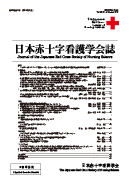Volume 20, Issue 1
Displaying 1-26 of 26 articles from this issue
- |<
- <
- 1
- >
- >|
Original Article
-
2020Volume 20Issue 1 Pages 1-8
Published: March 31, 2020
Released on J-STAGE: March 31, 2020
Download PDF (435K)
Research Reports
-
2020Volume 20Issue 1 Pages 9-16
Published: March 31, 2020
Released on J-STAGE: March 31, 2020
Download PDF (414K) -
2020Volume 20Issue 1 Pages 17-25
Published: March 31, 2020
Released on J-STAGE: March 31, 2020
Download PDF (519K) -
2020Volume 20Issue 1 Pages 26-34
Published: March 31, 2020
Released on J-STAGE: March 31, 2020
Download PDF (449K) -
2020Volume 20Issue 1 Pages 35-42
Published: March 31, 2020
Released on J-STAGE: March 31, 2020
Download PDF (421K) -
2020Volume 20Issue 1 Pages 43-51
Published: March 31, 2020
Released on J-STAGE: March 31, 2020
Download PDF (486K) -
2020Volume 20Issue 1 Pages 52-60
Published: March 31, 2020
Released on J-STAGE: March 31, 2020
Download PDF (454K) -
2020Volume 20Issue 1 Pages 61-69
Published: March 31, 2020
Released on J-STAGE: March 31, 2020
Download PDF (451K) -
2020Volume 20Issue 1 Pages 70-78
Published: March 31, 2020
Released on J-STAGE: March 31, 2020
Download PDF (543K) -
2020Volume 20Issue 1 Pages 79-88
Published: March 31, 2020
Released on J-STAGE: March 31, 2020
Download PDF (766K) -
2020Volume 20Issue 1 Pages 89-94
Published: March 31, 2020
Released on J-STAGE: March 31, 2020
Download PDF (345K)
Materials
-
2020Volume 20Issue 1 Pages 95-101
Published: March 31, 2020
Released on J-STAGE: March 31, 2020
Download PDF (449K) -
2020Volume 20Issue 1 Pages 102-108
Published: March 31, 2020
Released on J-STAGE: March 31, 2020
Download PDF (578K) -
2020Volume 20Issue 1 Pages 109-115
Published: March 31, 2020
Released on J-STAGE: March 31, 2020
Download PDF (387K) -
2020Volume 20Issue 1 Pages 116-121
Published: March 31, 2020
Released on J-STAGE: March 31, 2020
Download PDF (332K) -
2020Volume 20Issue 1 Pages 122-127
Published: March 31, 2020
Released on J-STAGE: March 31, 2020
Download PDF (389K)
The 20th Annual Congress of The Japanese Red Cross Society of Nursing Science
Chairperson’s Address
-
2020Volume 20Issue 1 Pages 131-136
Published: March 31, 2020
Released on J-STAGE: March 31, 2020
Download PDF (497K)
Special Address
-
2020Volume 20Issue 1 Pages 137-139
Published: March 31, 2020
Released on J-STAGE: March 31, 2020
Download PDF (266K)
Special Conversation
-
2020Volume 20Issue 1 Pages 140-146
Published: March 31, 2020
Released on J-STAGE: March 31, 2020
Download PDF (267K)
Educational Lecture
-
2020Volume 20Issue 1 Pages 147-151
Published: March 31, 2020
Released on J-STAGE: March 31, 2020
Download PDF (649K)
Theme Session
-
2020Volume 20Issue 1 Pages 152-156
Published: March 31, 2020
Released on J-STAGE: March 31, 2020
Download PDF (687K) -
2020Volume 20Issue 1 Pages 157-158
Published: March 31, 2020
Released on J-STAGE: March 31, 2020
Download PDF (215K) -
2020Volume 20Issue 1 Pages 159-160
Published: March 31, 2020
Released on J-STAGE: March 31, 2020
Download PDF (185K)
Symposium
-
2020Volume 20Issue 1 Pages 161-162
Published: March 31, 2020
Released on J-STAGE: March 31, 2020
Download PDF (200K) -
2020Volume 20Issue 1 Pages 163-164
Published: March 31, 2020
Released on J-STAGE: March 31, 2020
Download PDF (199K) -
2020Volume 20Issue 1 Pages 165-166
Published: March 31, 2020
Released on J-STAGE: March 31, 2020
Download PDF (217K)
- |<
- <
- 1
- >
- >|
